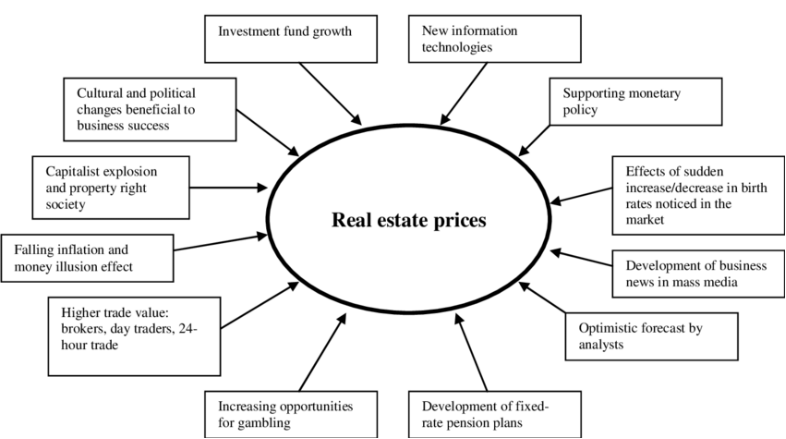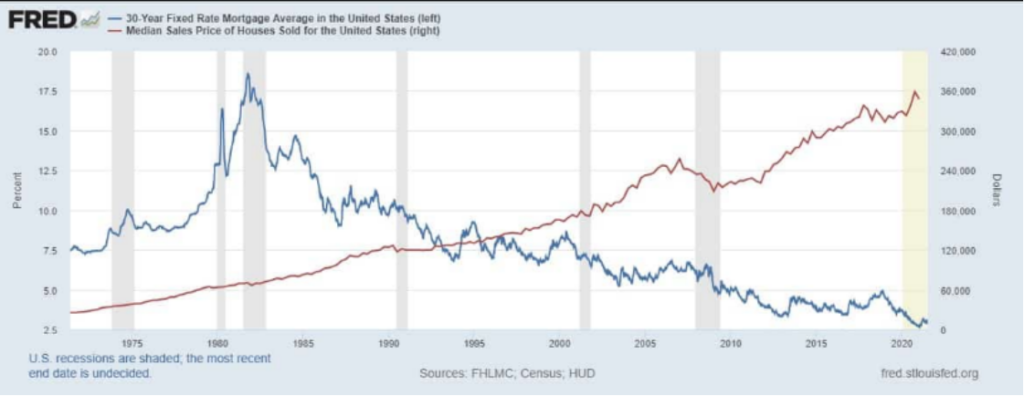უძრავი ქონების ბაზრისა და გავლენის ფაქტორების გააზრება
ძირითადი სასწავლო მიზნები:
შესავალი: Grasp the intricate relationship between interest rates, their historical context, and the profound influence they have on the real estate markets.
- Delve into the primary and secondary factors that shape the dynamics of real estate markets, including the significance of supply and demand and their impact on property valuation.
- Understand the intricate interplay between interest rates and real estate prices, and gain insights into how fluctuations in these rates can lead to significant shifts in property values.
- Familiarize yourself with pivotal moments in interest rate history and their corresponding effects on the real estate landscape.
- Appreciate the role of mortgage affordability in dictating real estate demand, and how it ties into the broader economic indicators.

Figure title: The Essence of Real Estate Investment and Value
წყარო: iStock:
In this section, we will delve into the various factors that influence real estate markets, the relationship between interest rates and real estate, and the role of economic indicators in real estate market dynamics.
A. Factors that Influence Real Estate Markets

ფიგურა: This infographic presents various strategies for real estate investments, highlighting methods such as “Driving for Dollars,” utilizing multiple listing services, engaging in outbound marketing, leveraging platforms like Craigslist, relying on word of mouth, advertising in newspapers, and participating in auctions. Each method offers a unique approach to identifying and securing real estate investment opportunities. This information is valuable for investors seeking diverse tactics to enhance their investment portfolio in the real estate market.
წყარო: მორგებული ინფოგრაფიკა
Supply and Demand: The balance between the number of available properties and the number of buyers is crucial in real estate markets, with high demand and low supply leading to rising prices, while low demand and high supply causing prices to fall.

Figure title: Indirect Factors Influencing Real Estate Prices (Based on Schiller, 2005)
წყარო: ResearchGate
აღწერა:
The figure provides an in-depth look into the indirect factors that influence real estate prices, based on Schiller’s 2005 study. This graphical representation might showcase various factors like economic indicators, social trends, policy changes, and other elements that indirectly impact property values.
ძირითადი დასკვნები:
- Economic Indicators: Factors like inflation, employment rates, and GDP growth can have indirect effects on property values.
- Social Trends: Migration patterns, urbanization, and demographic changes play roles in determining housing demand and prices.
- Policy and Regulations: Government policies, tax regulations, and housing laws can influence the appeal and affordability of real estate investments.
- Global Events: Events like financial crises, pandemics, or geopolitical tensions can have ripple effects on local real estate markets.
- Interconnectivity: The diagram underscores how these various factors are interconnected, collectively shaping the dynamics of the real estate market.
განაცხადი:
For investors, real estate professionals, and policymakers, understanding the indirect factors that shape property values is crucial. While direct factors like location, property condition, and amenities are often evident, these indirect influences can be subtle yet significant. By keeping abreast of broader economic, social, and political trends, stakeholders can make more informed decisions, anticipate market shifts, and strategize their investments or policies accordingly.
საპროცენტო განაკვეთები: Lower interest rates make financing a home purchase more affordable, increasing demand and driving up prices, while higher interest rates have the opposite effect.
Economic Growth and Employment Rates: Strong economic growth and low unemployment rates positively impact real estate markets, while weak economic growth and high unemployment rates reduce demand and lead to lower prices.
Location and Local Amenities: Desirable locations with good schools and amenities command higher prices, while less desirable areas have lower property values.
Government Policies and Regulations: Policies and regulations, such as zoning laws and tax policies, can influence supply, demand, and affordability in real estate markets.
B. Interest Rate History and Real Estate
შესავალი
Understanding the history of interest rates and their impact on real estate is crucial for any investor or homeowner. The relationship between interest rates and property values is complex but vital for forecasting market trends and making informed investment choices. In this chapter, we will dive into the history of interest rates and how they have influenced housing prices over time.
The Inverse Relationship between Interest Rates and Real Estate
As you’ve learned earlier, interest rates and real estate prices generally have an inverse relationship:
- Low Interest Rates: Lead to cheaper borrowing costs, thereby increasing the demand for real estate. This rise in demand generally pushes property prices up.
- High Interest Rates: Make borrowing expensive, reducing the number of people who can afford mortgages. This typically lowers demand and can lead to a decrease in property prices.

Figure title: The Relationship Between Interest Rates and Housing Prices
წყარო: InvestFourMore
აღწერა: The image displays two overlaid graphs, one tracking the Fixed Rate Mortgage Average in the United States and the other showing the Median Sales Price of Houses Sold in the United States. The time span appears to cover several years, with recessions indicated by shaded areas. The most recent recession’s end date is not determined. Data sources include FHLMC, Census, and HUD.
ძირითადი დასკვნები:
- Inverse Relationship: Typically, as interest rates rise, housing prices might decrease due to reduced borrowing capacity, and vice versa.
- ბაზრის დინამიკა: The meme might touch upon the common misconceptions or oversimplifications about how interest rates directly influence housing prices..
- Economic Implications: The underlying message underscores the importance of understanding economic drivers in the real estate market.
განაცხადი:
The meme serves as an engaging educational tool, especially for younger or less financially-savvy audiences. By breaking down complex topics like interest rates and housing prices into accessible content, readers can better understand market dynamics, make informed decisions when buying or selling property, or evaluate mortgage options. Such content also underscores the importance of staying updated with economic trends when navigating the real estate market.
C. Historical Overview of Interest Rates
- Post-War Period: In the decades following World War II, interest rates were relatively low, and there was a housing boom in many Western countries.
- The 1970s and Early 1980s: High inflation led to skyrocketing interest rates. Property prices stagnated or fell during this period due to high borrowing costs.
- Late 1990s to Early 2000s: A period of low-interest rates saw a surge in property prices, leading up to the housing bubble and the 2008 financial crisis.
- Post-2008: Interest rates have remained historically low to stimulate economic growth, contributing to a steady increase in real estate prices in many markets, although not without occasional corrections.

Figure title: Historical Trajectory of U.S. Interest Rates
წყარო: ვიზუალური კაპიტალისტი
აღწერა: The image provides a detailed look into the historical evolution of U.S. interest rates. Most likely depicted as a line graph or chart, the visual captures the fluctuations in interest rates over a specified period, highlighting key events, policy decisions, or economic conditions that influenced these rates. The graph has clear markers, dates, and annotations to ensure viewers understand the context and significance of each shift in the rates.
ძირითადი დასკვნები:
- Rate Fluctuations: The graph showcases the peaks and troughs of U.S. interest rates over time, giving insights into economic cycles and policy shifts.
- Economic Indicators: Significant events or conditions, such as recessions, economic booms, policy changes, or global crises, might be annotated to show their impact on interest rate decisions.
- Historical Context: The visual provides a comprehensive view of how interest rates have changed, offering insights into the Federal Reserve’s monetary policy and the broader economic environment.
- Comparative Analysis: Depending on the timeframe, the graph could provide a comparison between different eras or decades, highlighting how external factors influenced rate determinations.
აპლიკაცია: Understanding the historical context and trajectory of interest rates is invaluable for investors, policymakers, and financial professionals. These insights help in anticipating future rate movements, strategizing investments, or understanding the broader economic landscape. For those in real estate, finance, or even general businesses, being cognizant of interest rate trends can influence borrowing decisions, investment strategies, and economic forecasts.
D. The Mortgage Affordability Factor
Low-interest rates not only stimulate demand but also make monthly mortgage payments more affordable. As interest rates fall, people can afford homes they might not be able to at higher rates, thereby expanding the pool of potential buyers and driving up prices.
E. Other Factors to Consider
It’s crucial to remember that interest rates are just one piece of the puzzle. Other elements, such as supply constraints, population growth, and economic performance, also play a significant role in property valuation.
ძირითადი დასკვნები:
დასკვნითი განცხადება: Understanding the multi-dimensional nature of real estate markets, especially the pivotal role of interest rates and their historical significance, is crucial for insightful real estate investment decision-making.
- Real estate markets are shaped by an array of factors, both direct and indirect, with supply and demand being at the forefront.
- Interest rates have a profound and often inverse relationship with real estate prices; they serve as powerful levers influencing buyer demand and property valuation.
- The historical evolution of interest rates provides essential insights into their correlation with property values. Key historical events and epochs have played definitive roles in shaping this trajectory.
- Mortgage affordability, intrinsically linked to interest rates, serves as a key determinant in gauging the appeal of real estate for potential investors and homebuyers.

